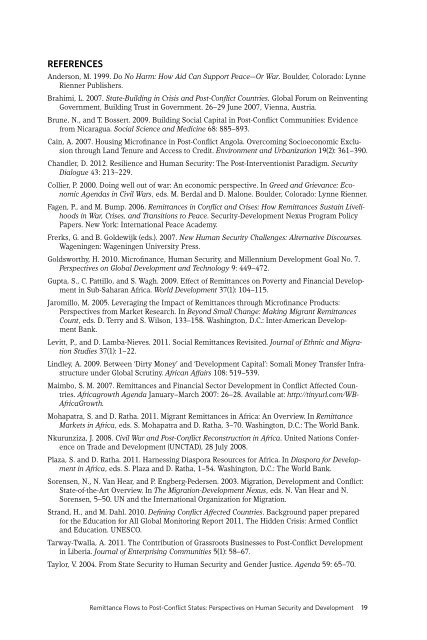Pardee-CFLP-Remittances-TF-Report
Pardee-CFLP-Remittances-TF-Report
Pardee-CFLP-Remittances-TF-Report
Create successful ePaper yourself
Turn your PDF publications into a flip-book with our unique Google optimized e-Paper software.
ReferencesAnderson, M. 1999. Do No Harm: How Aid Can Support Peace—Or War. Boulder, Colorado: LynneRienner Publishers.Brahimi, L. 2007. State-Building in Crisis and Post-Conflict Countries. Global Forum on ReinventingGovernment, Building Trust in Government. 26–29 June 2007, Vienna, Austria.Brune, N., and T. Bossert. 2009. Building Social Capital in Post-Conflict Communities: Evidencefrom Nicaragua. Social Science and Medicine 68: 885–893.Cain, A. 2007. Housing Microfinance in Post-Conflict Angola. Overcoming Socioeconomic Exclusionthrough Land Tenure and Access to Credit. Environment and Urbanization 19(2): 361–390.Chandler, D. 2012. Resilience and Human Security: The Post-Interventionist Paradigm. SecurityDialogue 43: 213–229.Collier, P. 2000. Doing well out of war: An economic perspective. In Greed and Grievance: EconomicAgendas in Civil Wars, eds. M. Berdal and D. Malone. Boulder, Colorado: Lynne Rienner.Fagen, P., and M. Bump. 2006. <strong>Remittances</strong> in Conflict and Crises: How <strong>Remittances</strong> Sustain Livelihoodsin War, Crises, and Transitions to Peace. Security-Development Nexus Program PolicyPapers. New York: International Peace Academy.Frerks, G. and B. Goldewijk (eds.). 2007. New Human Security Challenges: Alternative Discourses.Wageningen: Wageningen University Press.Goldsworthy, H. 2010. Microfinance, Human Security, and Millennium Development Goal No. 7.Perspectives on Global Development and Technology 9: 449–472.Gupta, S., C. Pattillo, and S. Wagh. 2009. Effect of <strong>Remittances</strong> on Poverty and Financial Developmentin Sub-Saharan Africa. World Development 37(1): 104–115.Jaromillo, M. 2005. Leveraging the Impact of <strong>Remittances</strong> through Microfinance Products:Perspectives from Market Research. In Beyond Small Change: Making Migrant <strong>Remittances</strong>Count, eds. D. Terry and S. Wilson, 133–158. Washington, D.C.: Inter-American DevelopmentBank.Levitt, P., and D. Lamba-Nieves. 2011. Social <strong>Remittances</strong> Revisited. Journal of Ethnic and MigrationStudies 37(1): 1–22.Lindley, A. 2009. Between ‘Dirty Money’ and ‘Development Capital’: Somali Money Transfer Infrastructureunder Global Scrutiny. African Affairs 108: 519–539.Maimbo, S. M. 2007. <strong>Remittances</strong> and Financial Sector Development in Conflict Affected Countries.Africagrowth Agenda January–March 2007: 26–28. Available at: http://tinyurl.com/WB-AfricaGrowth.Mohapatra, S. and D. Ratha. 2011. Migrant <strong>Remittances</strong> in Africa: An Overview. In RemittanceMarkets in Africa, eds. S. Mohapatra and D. Ratha, 3–70. Washington, D.C.: The World Bank.Nkurunziza, J. 2008. Civil War and Post-Conflict Reconstruction in Africa. United Nations Conferenceon Trade and Development (UNCTAD), 28 July 2008.Plaza, S. and D. Ratha. 2011. Harnessing Diaspora Resources for Africa. In Diaspora for Developmentin Africa, eds. S. Plaza and D. Ratha, 1–54. Washington, D.C.: The World Bank.Sorensen, N., N. Van Hear, and P. Engberg-Pedersen. 2003. Migration, Development and Conflict:State-of-the-Art Overview. In The Migration-Development Nexus, eds. N. Van Hear and N.Sorensen, 5–50. UN and the International Organization for Migration.Strand, H., and M. Dahl. 2010. Defining Conflict Affected Countries. Background paper preparedfor the Education for All Global Monitoring <strong>Report</strong> 2011, The Hidden Crisis: Armed Conflictand Education. UNESCO.Tarway-Twalla, A. 2011. The Contribution of Grassroots Businesses to Post-Conflict Developmentin Liberia. Journal of Enterprising Communities 5(1): 58–67.Taylor, V. 2004. From State Security to Human Security and Gender Justice. Agenda 59: 65–70.Remittance Flows to Post-Conflict States: Perspectives on Human Security and Development 19


